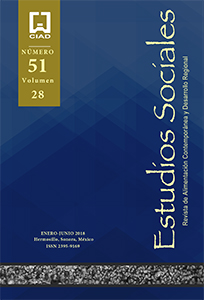Granjas avícolas y autosuficiencia de maíz y soya: caso Tungurahua-Ecuador
Poultry farms and self-sufficiency of corn and soy: Case Tungurahua-Ecuador
Abstract
Objective: To characterize poultry farms and self-sufficiency of corn and soybeans, in Tungurahua-Ecuador. Methodology: Interviews were carried out with 90 selected poultry farmers through non-probabilistic sampling, production and export statistics reported by the Association of Balanced Manufacturers (AFABA) and the Ministry of Agriculture, Livestock, Aquaculture and Fisheries (MAGAP) were used, and Average Rates of Cumulative Variation and self-sufficiency and food dependence were calculated. Results: In Tungurahua, 78% of poultry farmers are engaged in raising poultry and 62% have semi-automated facilities. The 100% of corn and soybean used by the poultry of Tungurahua, comes from other provinces and international imports. Between 2007 and 2016, maize recorded an annual average self-sufficiency rate of 0.9, while soybean yielded 0.08. Limitations: Statistical information on domestic production and imports of grains was scattered. Conclusions: the results indicate the presence of different types of poultry production systems. These, depending on the level of technology, range from crafts to automation. Likewise, the national production reaches to cover with difficulty the national demand of the poultry sector, not the national soy that covers a minimum part. Based on these results it is suggested to maintain the policy of import substitution of yellow maize and to expand soybeansKeywords:
Contemporary food, poultry, balanced, farms, production systems, imports.Abstract
Objective: To characterize poultry farms and self-sufficiency of corn and soybeans, in Tungurahua-Ecuador. Methodology: Interviews were carried out with 90 selected poultry farmers through non-probabilistic sampling, production and export statistics reported by the Association of Balanced Manufacturers (AFABA) and the Ministry of Agriculture, Livestock, Aquaculture and Fisheries (MAGAP) were used, and Average Rates of Cumulative Variation and self-sufficiency and food dependence were calculated. Results: In Tungurahua, 78% of poultry farmers are engaged in raising poultry and 62% have semi-automated facilities. The 100% of corn and soybean used by the poultry of Tungurahua, comes from other provinces and international imports. Between 2007 and 2016, maize recorded an annual average self-sufficiency rate of 0.9, while soybean yielded 0.08. Limitations: Statistical information on domestic production and imports of grains was scattered. Conclusions: the results indicate the presence of different types of poultry production systems. These, depending on the level of technology, range from crafts to automation. Likewise, the national production reaches to cover with difficulty the national demand of the poultry sector, not the national soy that covers a minimum part. Based on these results it is suggested to maintain the policy of import substitution of yellow maize and to expand soybeansKeywords:
Contemporary food, poultry, balanced, farms, production systems, imports.Downloads
Published
How to Cite
Issue
Section
Para que sean publicados artículos, ensayos y reseñas críticas en Estudios Sociales, la revista debe contar con la aceptación de parte de los autores/autoras de las condiciones siguientes:
1. Los autores conservan los derechos de autor y ceden a la revista el derecho de la primera publicación del trabajo registrado bajo la licencia de Creative Commons Reconocimiento-NoComercial (CC-By-NC) que permite a terceros utilizar lo publicado, siempre y cuando mencionen la autoría del trabajo y a la primera publicación en esta revista.
2. Los autores pueden realizar otros acuerdos contractuales independientes y adicionales para la distribución no exclusiva de la versión del artículo publicado en esta revista (por ejemplo: incluirlo en un repositorio institucional o publicarlo en un libro) siempre y cuando indiquen, claramente, que el trabajo se publicó por primera vez en esta revista.




















